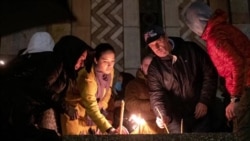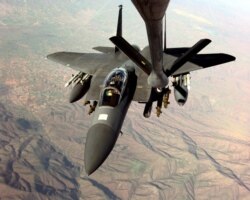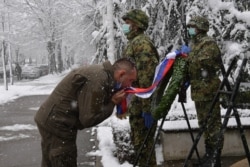On March 24, 1999, the North Atlantic Treaty Organization (NATO) launched Operation Allied Force against the Federal Republic of Yugoslavia (FRY) during the Kosovo War.
NATO said the large-scale air campaign was intended to halt Serbian forces’ ethnic cleansing against ethnic Albanian Muslims in Kosovo. The bombing came to an end on June 10, 1999, after FRY President Slobodan Milosevic agreed to withdraw troops from Kosovo and allow in peacekeepers.
Kosovo Albanian refugees were allowed to return home, and Kosovo was given self-rule, paving the way for full independence. Milosevic died in 2006 while standing trial for war crimes in The Hague.
This week, Russia, which has always condemned the NATO airstrikes in the FRY as illegal, issued a statement via its U.K. embassy on the 22nd anniversary of the NATO campaign.
“#OTD in 1999 #NATO started its military aggression against #Yugoslavia. During the barbaric bombings over 2000 peaceful civilians, incl children, lost their lives. That @NATO aggression became the first armed offence against a sovereign state in Europe since the end of #WWII,” the embassy tweeted.
Many aspects of this statement are false or lacking context.
Although there might be some debate over what constitutes a “sovereign" state, the Soviet Union launched several military offensives in Europe, outside the Soviet Union’s borders, prior to Operation Allied Force.
The targeted countries were members of the Warsaw Pact, a collective defense treaty established by the Soviet Union in 1955.
For example, in June 1953, the Soviet Union deployed an entire armored division, which includes tanks, to crush a workers’ uprising in East Germany. Three years later, on November 4, 1956, the Soviets launched "Operation Whirlwind” to stamp out a revolution in Hungary.
Employing heavy air strikes, artillery fire and tank-infantry attacks, an estimated 2,500 Hungarians died and 200,000 more became refugees in that assault. Hungary’s Prime Minister Imre Nagy was arrested, tried in secret, and executed.
On August 20, 1968, Soviet military forces, along with those of Warsaw Pact members Poland, Bulgaria, East Germany and Hungary, invaded Czechoslovakia to crush attempts at liberalization known as the Prague Spring.
An estimated 200,000 Warsaw Pact troops and 5,000 tanks were dispatched in what was called “the largest deployment of military force in Europe since the end of World War II.”
In 1974, Turkish forces invaded Cyprus, which had gained its independence from Britain in 1960 and later became the 99th member of the United Nations.
Russia’s description of the 1999 bombing campaign as “military aggression” does have weight. NATO did not have United National Security Council backing to launch the campaign. Nor had Yugoslavia attacked a NATO member, allowing collective self-defense under Article 51 of the U.N. charter.
However, repeated attempts to force Milosevic to end attacks on Kosovar Albanians through diplomacy and targeted sanctions had no effect.
An estimated 250,000 Kosovar Albanians were driven from their homes by the autumn of 1998, and, with a humanitarian catastrophe looming, events like the January 1999 Racak massacre contributed to the decision to use military force.
Some analysts argue that NATO’s actions in Kosovo should be viewed in the context of “the largest act of mass killing in Europe” – the Bosnian genocide that Serbia and ethnic Bosnian Serbs had carried out a few years earlier.
Milosevic was accused of directly supporting Serb paramilitaries and directing Serb forces during those ethnic cleansing campaigns in Bosnia.
The day the NATO bombing campaign in the Kosovo War started, then-U.N. Secretary General Kofi Annan characterized military action as a regrettable but necessary last resort:
“Throughout last year, I have appealed on many occasions to the Yugoslav authorities and to the Kosovar Albanians to seek peace over war, compromise over conflict. I deeply regret that in spite of all the efforts made by the international community, the Yugoslav authorities have persisted in their rejection of a political settlement which would have halted the bloodshed in Kosovo and secured an equitable peace for the population.
“It is indeed tragic that diplomacy has failed, but there are times when the use of force may be legitimate in the pursuit of peace.”
Still, the legality of NATO’s bombing campaign in Kosovo remains murky.
In December 2014, the International Court of Justice dismissed on jurisdictional grounds complaints filed by Serbia and Montenegro, which constituted the FRY, against 10 NATO members for the bombing of Kosovo. The FRY, which was established in April 1992, was not recognized as the official successor to the Socialist Federal Republic of Yugoslavia. When asked to apply for U.N. membership, the FRY refused. Consequently, the FRY was not a member of the U.N., and had no standing before the top U.N. court.
Still, NATO was criticized for several of their bombing targets. Amnesty International called the NATO bombing of the Radio Television of Serbia headquarters, which killed 16 civilians, a war crime.
NATO rejected that charge. A report by the United Nations International Criminal Tribunal for the former Yugoslavia (ICTY) said that “the attack appears to have been justified by NATO as part of a more general attack aimed at disrupting the FRY Command, Control and Communications network, the nerve center and apparatus that keeps Milosevic in power.”
The ICTY further stated that “the civilian casualties were unfortunately high but do not appear to be clearly disproportionate.”
More broadly, a NATO report issued one year after the campaign listed its goals and challenges:
“The bulk of NATO’s effort against tactical targets was aimed at military facilities , fielded forces, heavy weapons, and military vehicles and formations in Kosovo and southern Serbia. Many of these targets were highly mobile and hard to locate, especially during the poor weather of the early phase of the campaign. Strikes were also complicated by the cynical Serb use of civilian homes and buildings to hide weapons and vehicles, the intermixing of military vehicles with civilian convoys and, sometimes, the use of human shields.”
The available data appears to confirm that NATO mainly targeted FRY military, not civilians.
During the 78-day air campaign, NATO aircraft flew 38,400 sorties, including 10,484 strike sorties, in which 23,614 air munitions were dropped. An extensive fact-finding mission by Human Rights Watch (HRW) concluded “that as few as 489 and as many as 528 Yugoslav civilians were killed.” HRW noted that 62% to 66% of the total civilian deaths occurred in twelve incidents.
Based on that bombing-to-civilian-casualty ratio, the ICTY determined: “These figures do not indicate that NATO may have conducted a campaign aimed at causing substantial civilian casualties either directly or incidentally.”
The U.N. tribunal also noted an FRY Ministry of Foreign Affairs’ publication, “NATO Crimes in Yugoslavia,” which included an estimate of “495 civilians killed and 820 civilians wounded in specific documented instances.”
Russia’s U.K. embassy did not explain how it arrived at the figure of 2,000 deaths caused by the NATO bombing campaign.
By contrast, the Kosovo Memory Book database, which documents deaths from 1998–2000, puts the overall number of war victims at 13,535. It said that “10,317 civilians lost their lives or went missing in connection with the war, of whom 8,676 were Albanians.”
In terms of civilian deaths, another 1,196 Serbs, and 445 Roma and other civilians lost their lives.
According to the Human Rights Data Analysis Group, an NGO, the Kosovo Memory Book database “documents all or nearly all the human losses” during the conflict.
NATO was also criticized for its use of cluster munitions and depleted uranium projectiles during the Kosovo War. However, in both cases, the U.N.’s ICTY concluded that, based on the available evidence, the tribunal's Office of the Prosecutor “should not commence an investigation into their use.”
The ICTY did not address the legality of NATO’s decision to use force in Kosovo.









